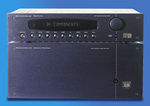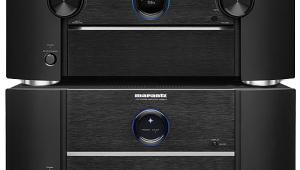To Separate or Not to Separate? Page 2
 One of the best criteria of a good amplifier is its ability to deliver current. Short of popping the top for a peek inside, one of the easiest ways to judge an amp's talents in this area is to look at what it does at lower impedances (if the spec sheet includes this). For example, an amplifier that legitimately doubles its power output whenever the impedance is halved (e.g., 4 ohms versus 8 ohms) is throwing a lot of current, which is almost always a sign that it's well-built and well-designed, although not a guarantee that it sounds good. The lower the impedance that your speakers present, the more current your amp must deliver—and the more the men are separated from the boys in the power game.
One of the best criteria of a good amplifier is its ability to deliver current. Short of popping the top for a peek inside, one of the easiest ways to judge an amp's talents in this area is to look at what it does at lower impedances (if the spec sheet includes this). For example, an amplifier that legitimately doubles its power output whenever the impedance is halved (e.g., 4 ohms versus 8 ohms) is throwing a lot of current, which is almost always a sign that it's well-built and well-designed, although not a guarantee that it sounds good. The lower the impedance that your speakers present, the more current your amp must deliver—and the more the men are separated from the boys in the power game.
How does this relate to our receivers-versus-separates discussion? Put simply, power and (more importantly) current in an amplifier (whether the amp is separate or part of a receiver) are products of the size and quality of the amp's transformer and capacitors, as well as the quality and number of output transistors per channel. I am, of course, talking strictly about solid-state designs. All of these components are expensive and require a fair amount of chassis space, especially the transformer. The bigger these components are (or, in the case of output transistors, the more there are), the more they can offer. Now you know why cost-no-object monoblocks are usually at least twice the size and weight of any receiver or multichannel amplifier. Transformers and transistors can also get very hot, requiring ventilation or heatsinking, which also adds to the cost and demand on chassis space.
With a receiver, the bottom line is that chassis space is at a premium, so its design must always prioritize space efficiency over maximum power output. Imagine the difficulty of packing five or seven channels of amplification into a limited chassis space that also has to accommodate all of the other circuitry a receiver employs, not to mention the fact that all of these entities must share a power supply. Inevitably, compromises of one form or another must be made in a receiver's design. Multichannel amps aren't immune to these concerns either, but separates will always have the theoretical edge in real power—given that even a multichannel amplifier will have a chassis that is at least as big as a receiver's but only needs to accommodate power components.
That being said, don't underestimate most receivers' ability to hold their own quite nicely in a home theater setup. The reason is a simple adherence to one of the age-old keys to home theater success: matching. Proper matching manifests itself in many ways; however, for our purposes, I'll concentrate on the amplifier-speaker bond (probably the most critical of all). The receiver game is highly market-driven—something I'll get into more in a moment—and manufacturers put a great deal of effort into determining what types of speakers people are most likely to mate with a receiver. On the flip side, the speaker manufacturers have a good idea about people's budgets and adjust their design philosophies accordingly.
The end result is a greater number of efficient, sensitive, higher-impedance speakers in the lower price categories, where receivers are more likely to dominate the market. A speaker with a sensitivity rating in the high 80s or low 90s and an 8-ohm nominal impedance will usually run fine off a receiver with any decent power behind it. So, there are a lot of speaker models with these specs at the same price point as most receivers. Remember, impedance varies with frequency, but you don't generally see less-expensive speakers that dip into the low-impedance loads that handcuff most receivers. Sensitivity is a critical concern, as well: Every 3-decibel decrease in speaker sensitivity requires twice as much amplification (e.g., you need twice as much power to drive an 87-dB-sensitive speaker to the same level as a 90-dB-sensitive speaker). It's only when we get into the lower impedances and the lower sensitivities (found on most higher-end systems) that we see speakers that require a level of current that most receivers simply can't deliver.
Beyond the limited chassis space, which most notably affects power components, the basic receiver design really doesn't have any other major deficiencies that can be chalked up to purely technological issues. Compromises beyond chassis space are more a product of what I'll loosely call marketing decisions. As I alluded to earlier, the receiver world is intensely market-driven, and the trick to surviving is to offer the most that you can for the lowest price. Performance may not always receive as much priority as it should. Obviously, not many people are going to buy a product that doesn't sound good, but the general assumption is that receiver manufacturers are under far more pressure to cut corners in certain areas (like the quality of internal componentry) in order to hit a certain price point and remain competitive. These compromises can be relatively minor, like using standard jacks and binding posts instead of gold-plated ones, or far more noticeable, such as using inferior-quality surround processors or digital-to-analog and analog-to-digital converters. Trust me, there are compromises in separates, as well; however, the pressure isn't nearly as intense, and the budgetary restrictions aren't nearly as rigid in the separates market. Only at the high end of the receiver market will you start to consistently see the same level of quality internal components that is standard fare in separates (beyond the occasional budget separates system).
















































